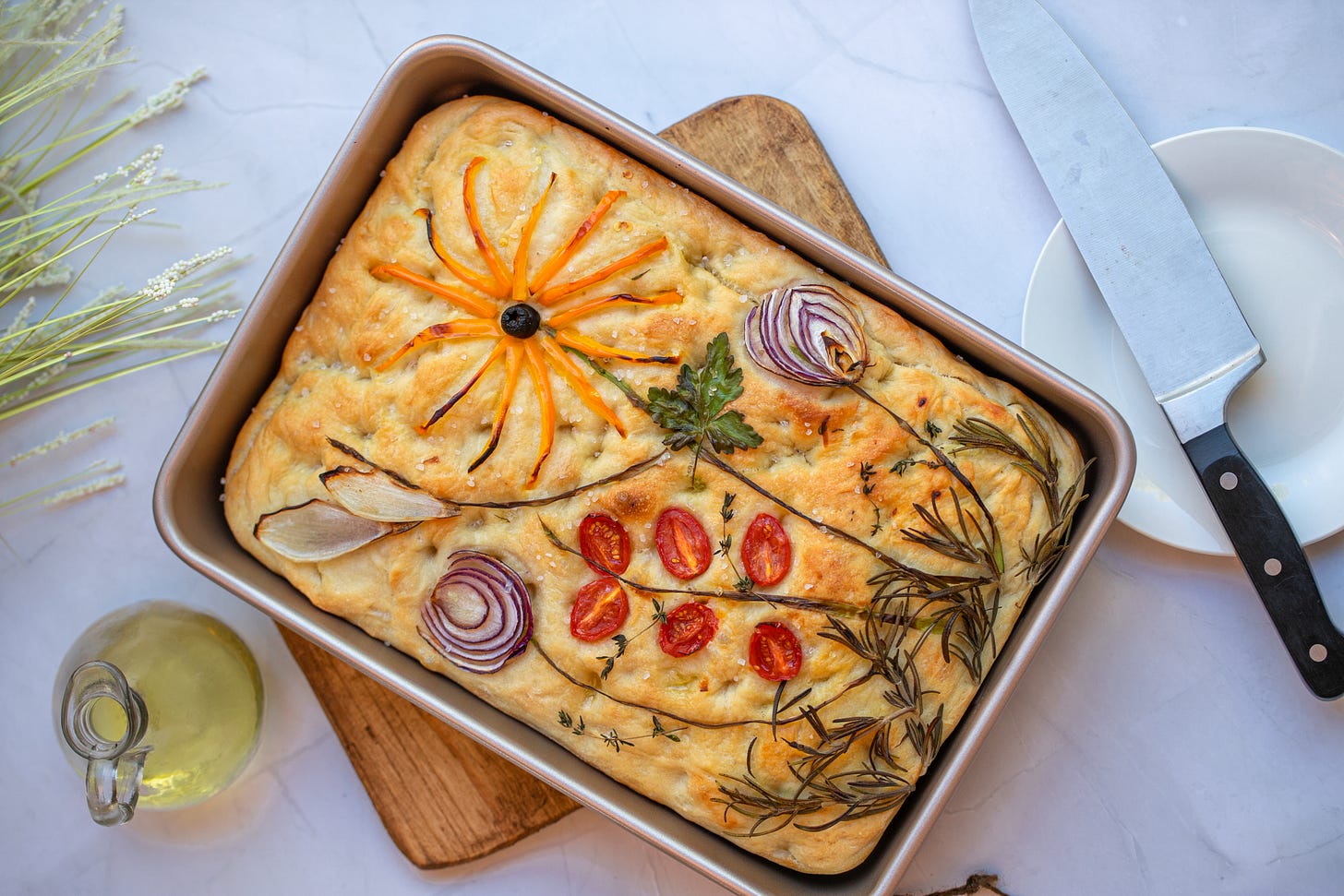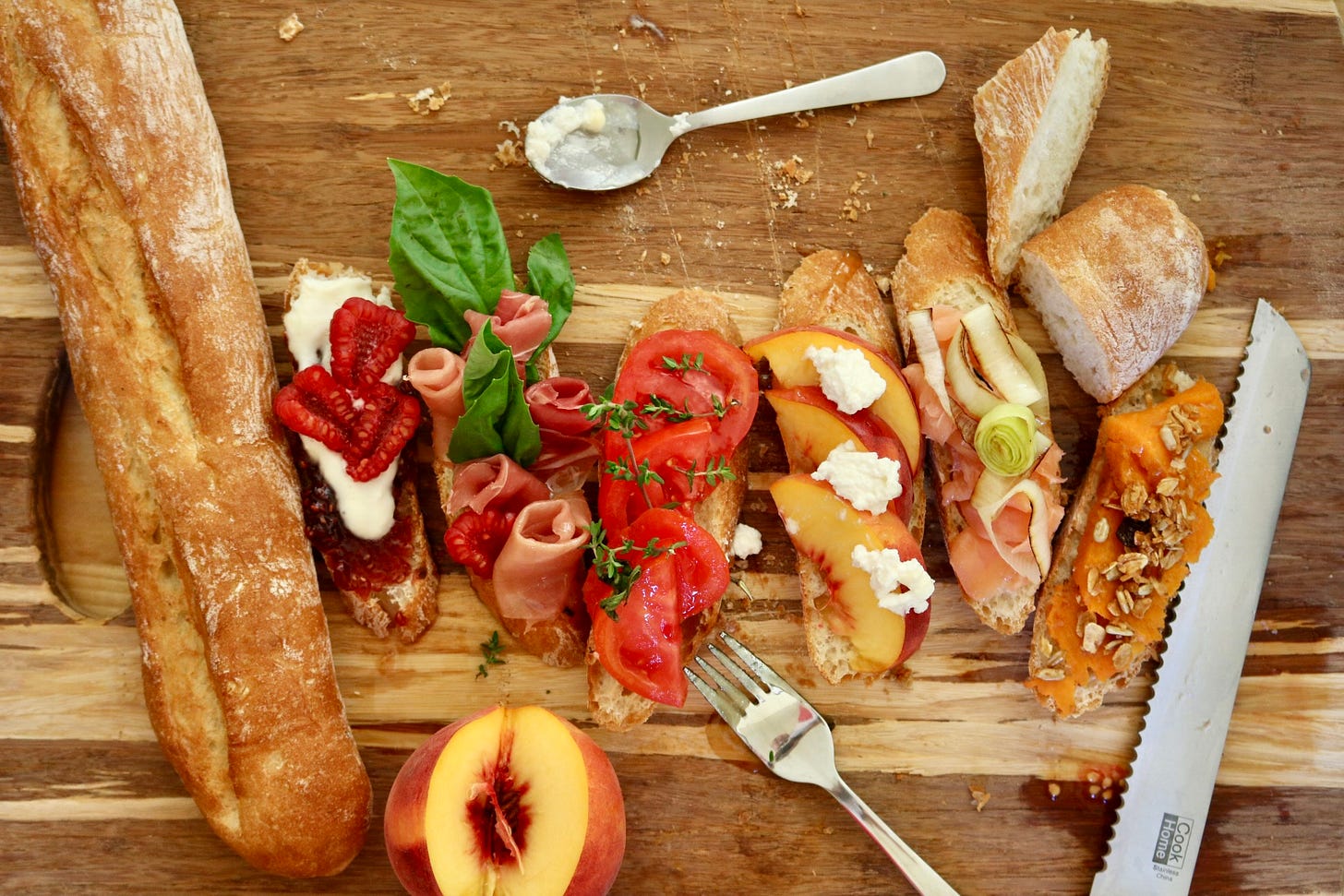French Lessons: Why French Bread Has 4 Ingredients and Ours Has 40
Recipe: Wildflower Focaccia ((collab with Garlyn Manganiello)
*This newsletter is not intended to be medical advice. Supported by Mandy Murphy Carroll, RD MPH, Dr. Rosa Keller, PHD RD, Dr. Ricki Pollycove OBGYN, & Dr. Claire Packer OBGYN
Welcome to Modern Women’s Nutrition!
Empowering the busy modern woman to understand her hormone & metabolic health, and how to eat to thrive at every step of her journey—from fertility to menopause and beyond.
Before I begin — quick HAPPY BIRTHDAY TODAY to my love, Spencer!!!!!!!!!!!!!!!
Also a short shameless self-promo: I want to introduce you, my Substack VIPs, to a very special 8-week Blood Sugar Method Course I’ve created with holistic nutritionist
.If you’ve been loving my recipes and want help with…
Balancing your blood sugar naturally
Reclaiming your energy and mental clarity
Ending cravings and hunger swings for good
Making delicious, real food a sustainable lifestyle
…this might be a good option for you!
This week only, you’ll get an early bird special: $50 OFF the self-paced, 6-week Blood Sugar Method Course, PLUS access to our monthly membership, where you'll get direct access to our team of experts, receive monthly recipes + menus, join the support group, and so much more.
This isn't just another diet program, it’s a game-changer for folks who want ongoing wellness support, 5-star recipes, and access to experts.
Use code EARLYACCESS50 for $50 off The Course + Membership Bundle!!
Discount expires April 30th at midnight.
→ Jump to Recipe: Wildflower Focaccia

Hi gals,
A few weeks ago, I wrote about how moving to France helped me break the cycle of overeating and restriction that I’d lived with for most of my adult life. Your response was incredible!! I am so grateful to have heard from so many of you about how this topic resonated, and how you felt about it. Thank you for your emails, comments, likes and texts, it means so much more than you know. 💜
As I discussed, when moving to France, there was no magic fix. No big breakthrough. Just a quiet, daily recalibration. It was all about a slower pace, eating real meals mindfully and intentionally, and sinking into a food culture that is designed to work with the body, not fight it.
Which brings me to this week’s French lesson: It starts with a baguette.
Not just any loaf, but a crusty, chewy-in-all-the-right-ways, fresh-from-the-oven French baguette. That baguette that you see the older man down the street carrying home every morning, fresh from the market, in a wicker basket, with his class béret hat on.
It wasn’t long after we moved to France—I was standing in our local boulangerie, baguette tucked under my arm. I don’t usually buy bread, but it just smelled so good. I’d already ripped off the end, impatient, peckish, when I turned to the baker behind the counter and I asked what was in it.
He blinked at me like I’d asked how many ingredients are in a glass of water.
Farine, eau, sel, levure, he said, already moving on to the next customer.
Flour. Water. Salt. Yeast.
C’est tout. That’s all.
Meanwhile, in the U.S., a loaf of “healthy” bread often contains 15… 20… sometimes 40 ingredients. Wait, what?
That is not an exaggeration. That’s on the label — go take a look!
And it got me thinking:
Why does French bread have four ingredients—and ours has forty? Does this have to do with country-by-country laws, or is it simply by choice? Or both?
In France, a baguette is more than bread, it’s a protected cultural artifact.
Seriously. In 1993, the French government passed a law governing traditional baguettes. The Décret n°93-1074, also known as the “Décret Pain”, was issued by the French government on September 13, 1993, to protect the integrity of the baguette de tradition française. It’s a regulation that legally defines what can—and cannot—go into a traditional baguette. The real thing is made with only wheat flour, water, salt, and yeast. No preservatives. No additives. No bells and whistles.
Baguettes must also be made on-site at the bakery where they’re sold. Never factory made or frozen. That’s why the corner boulangerie always smells like warm, just-out-of-the-oven bread. It’s baked, bought, and eaten, usually within the same day.
This isn’t just tradition, it’s science-backed policy.
In the EU, food regulation follows the precautionary principle: if there’s reason to believe an ingredient might be harmful, it’s pulled or restricted until it’s shown to be safe.
In the U.S., the opposite tends to be true: if it hasn’t been definitively proven harmful, it’s allowed, often for decades.
That’s why ingredients like titanium dioxide, banned in the EU due to DNA damage risk, still appear in U.S. products (source).
In the States, even basic foods—like sandwich bread, chocolate bars, or nut milk—often contain a cocktail of additives: preservatives, colorants, dough conditioners, flavor enhancers, and emulsifiers.
Emulsifiers are a big one! They’re used to keep food smooth, stable, and shelf-ready, but most of us have no idea we're consuming them. Emulsifiers are found in the majority of foods consumed in the U.S., and the FDA has approved a staggering 171 of them (source), compared to just 63 in the UK (source).
Disturbingly, many emulsifiers haven’t been thoroughly tested in humans, especially not for long-term or cumulative effects. Yet animal studies have linked some emulsifiers to gut microbiome disruption, inflammation, and even increased risk of metabolic syndrome (source).
And … if that’s not enough, further research indicates that emulsifiers may alter gut microbiota composition and promote chronic intestinal inflammation (source).
And if that isn’t enough, a large-scale French study recently tied emulsifier intake to a higher risk of cardiovascular disease (source). Yikes.
These are some of the other questionable ingredients still widely used in the U.S.:
Potassium Bromate
Used to strengthen dough, it’s classified as “possibly carcinogenic to humans” by the IARC due to tumor development in lab animals (source).
BHA (Butylated Hydroxyanisole)
A common preservative in chips, cereals, and chewing gum, BHA is “reasonably anticipated to be a human carcinogen,” according to the U.S. National Toxicology Program (source).
BHT (Butylated Hydroxytoluene)
Used similarly to BHA, BHT has shown possible tumor-promoting effects in animals. The EU allows it in regulated cosmetic concentrations, but notes potential endocrine disruption – yes, directly disrupting our hormones, which regulate everything our body does (source).
Titanium Dioxide (E171)
This whitening agent, used in candies and baked goods, has been shown to cause DNA damage in animal cells, prompting the EU to ban it in 2021 (source).
FYI – white is so faux-pas, look for color in your food.
My message from all of this: We’ve been taught to look the other way, to say: “But how else am I supposed to eat?”, and therefore to be lazy. I hear and see this all day long.
Realistically, it doesn’t take that much effort to find other foods to eat that don’t give you cancerous carcinogens, DNA damage and hormone disrupters.
And that’s why I write these newsletters – to provide you with realistic alternatives that help you thrive. And encourage you to cook more often, too.
The unfortunate truth is that the U.S. food system wasn’t designed with your long-term health in mind. It was designed for shelf life, profit margins, convenience, and scale.
We want to be able to shop at Costco once every two weeks and not have to return to the grocery store. But sadly, there’s a massive health price to pay in this case.
You don’t need to look any further than GRAS to see this in action. The U.S. Food and Drug Administration allows manufacturers to self-certify new ingredients as “Generally Recognized as Safe” (GRAS), a designation that bypasses independent testing or FDA approval.
“Generally”??? What is “generally” when we’re talking about the safety of our families??
On top of that, a 2010 Government Accountability Office report notes that companies aren’t even required to notify the FDA when they introduce a new GRAS substance (source). They can just quietly add it to our food supply (yikes!).
This means you may be consuming ingredients that have not been thoroughly studied in humans. Or ingredients that were deemed “safe” decades ago, before we understood their effects on the gut, hormones, or growing children.
So, it’s not just about what could be harmful, it’s about how much you don’t know about the food that you’re eating. If you want to make food choices that protect your body (and your family) it’s necessary to get informed. If you decide to look away, you could be shortening your lifespan, and that of your children, too.
Knowledge is power.
When I look at the food laws here in France, I feel a little more protected.
And it makes me wonder:
What if our food system was actually designed to keep us safe?
What if fewer ingredients meant more trust in the people who are making our food, not less?
What if clean, safe food wasn’t the exception, but the expectation?
I don’t have all the answers. But I do know this: Since moving here, my digestion has calmed, my skin looks clearer, my energy feels more even, my weight is more steady, and I’m sleeping through the night more often than not.
It’s not because I’ve overhauled my routine or started some perfect wellness protocol. It’s not even because I’ve intentionally made changes in my diet and habits. I actually “splurge” quite a bit — eating all of the beautiful indulgent foods and going out to dinner multiple times per week.
It has to do with the food and the way of eating it. I know that I can trust what’s in the markets, at the restaurants, and on my plate.
Paid subscribers: Want to eat more like the French, without moving across the Atlantic? Here are 10 easy-to-implement, research-informed tips to help you eat cleaner, simpler, and smarter, even inside a broken food system. Get the tips + the delicious recipe of the week: Wildflower Focaccia (a rare white-flour experience—upgraded with vibrant veggies for fiber, nutrients, and color!).
Keep reading with a 7-day free trial
Subscribe to Modern Women's Nutrition to keep reading this post and get 7 days of free access to the full post archives.











